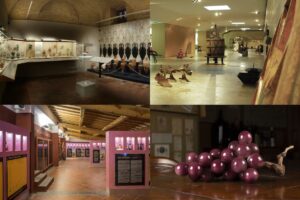One of the most important resources, and among the few not “relocated”, is the Italian rural landscape: it is a cultural heritage that between tourism and typical wine and food sectors produces more than 10 billion euros per year. Yet in the last 60 years, due to unauthorized building and urban sprawl, it has suffered damages for 25 billion euros, reveals CIA – the Italian Farmers Confederation, in a study conducted during the National Fair of Agriculture in Turin that investigated the evolution of the relationship between landscape and rural life from 1861 to today. “From 1861 to today, agricultural land has lost almost 10 million hectares, equal to the total area of 5 Italian regions like Veneto, Lombardy, Piedmont, Emilia Romagna and Friuli Venezia Giulia. Construction,” says the CIA, “has compromised the integrity of wonderful locations that are the magnets of “green tourism”, like the large areas of olive groves in the Salento area, the vineyards courageously perched on the steep Ligurian coast, the multicolored carpet of lots on the plains of Castelluccio or the inaccessible hills of Gallura cork: these are unique environments where the landscape has been shaped over time through farming. They have became a source of attraction for the growing number of visitors to farmhouse holidays - which alone reach an annual turnover of 1 billion euros - and all lovers of traditional cuisine, linked to the territory of origin”.
The gradual erosion of cultivated land “has changed the face of the entire Boot, since Italy was an agricultural country in all respects, and two thirds of the territory was farm land. In 1861, there were 22 million hectares of farm land while today there are 12 million hectares, equal to just over one third of the total area of the peninsula”.
These numbers translate into a radical change of the landscape that began in the 1950s and peaked in the 1970s, when urban sprawl contributed to defacing the countryside. “Farm land changed radically at this stage: from bare, wild and completely lacking in infrastructures at the beginning of the century when most of the area was planted with crops or for pasture, to a crop selection that followed a criteria of productivity.
The area devoted to grains was 7.3 million hectares in 1910 while today it is 3.2 million hectares: 1 million hectares were lost between 1951 and 1971 alone. Other crops, such as fruits and vegetables, have instead gained ground: from just a few thousand hectares then to one million two hundred thousand hectares today. Those were the years of the “economic boom”, when land paid a heavy price due to exceptional national development and unstoppable construction, which relentlessly ravaged the countryside, robbing and defacing the land”.
The transformation of the land, which is the testimonial of Italian economic and social history, mainly means - according to the CIA - different relationships with the environment. At one time it was completely alien to politics, while in recent years it has become the key to protecting this wealth. In the 1960s agriculture became the common heritage in Europe, with the creation of CAP (Common Agricultural Policy), which at first was based exclusively on productivity.
The environmental aspect became an integral part of agricultural policies only much later. In 2000 the second pillar of rural development was inserted in the CAP providing for rewarding environment-friendly agriculture that protects and enhances the land and its heritage of agricultural biodiversity, in constant danger of extinction.
“It is here that for the first time,” the CIA continues, “farmland is regarded as an economic resource, capable of producing wealth, both through “green” tourism and through the turnover related to the excellent, typical and closely linked to the territory products, for which Italy boasts absolute primacy in Europe with its 228 appellations of origin”. And the route that continues to protect and upgrade our land should not slow down.
Focus – Green is also advancing in ... Turin, where environmentalists from around the world met: the honorary President of the FAI (Italian Environment Fund), Giulia Maria Mozzoni Crespi and the Director of Expo 2015 in Milan, together with personalities of the agricultural world – the President of the farmers of CIA, Giuseppe Politi. Several examples were presented in which land, the greenery and agriculture come together in a virtuous way. In addition to the presentation of the Cervi Institute and Sereni Library successful experiment “Summer School”, by the Director of the school, Antonio Brusa, other successful projects were also discussed: the revaluation of the peri-urban area in the South Park of Milan and also the marvelous example of the Kolimbetra garden, an antique orange grove re-planted in the heart of the Valley of the Temples in Agrigento. All the examples talked about a new relationship between green and cities, where agriculture often penetrates the city walls. Gianluca Cristoni, the “green entrepreneur” also participated and presented the latest urban design, urban planning projects in which green creeps into construction in a new way, penetrating into the spaces and gaps in the internal texture of city buildings. Vertical gardens and orchards, or “roof gardens” are the new forms of green in our cities, inspired by using all possible areas and vertical spaces.
Copyright © 2000/2025
Contatti: info@winenews.it
Seguici anche su Twitter: @WineNewsIt
Seguici anche su Facebook: @winenewsit
Questo articolo è tratto dall'archivio di WineNews - Tutti i diritti riservati - Copyright © 2000/2025








































































































































































































